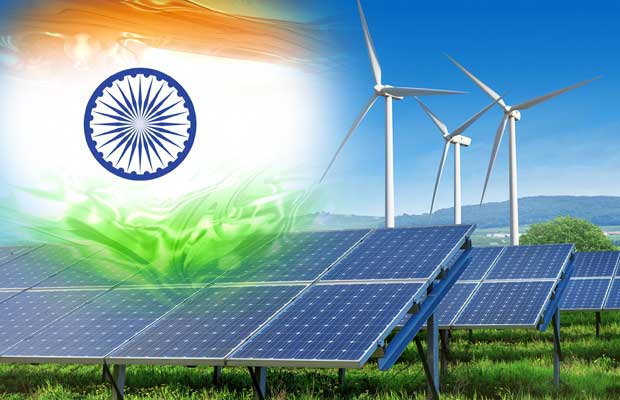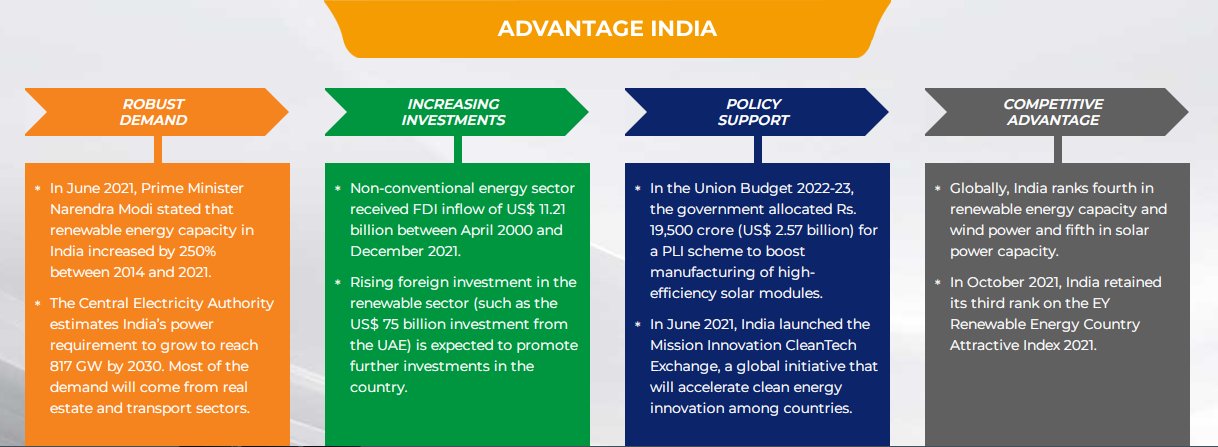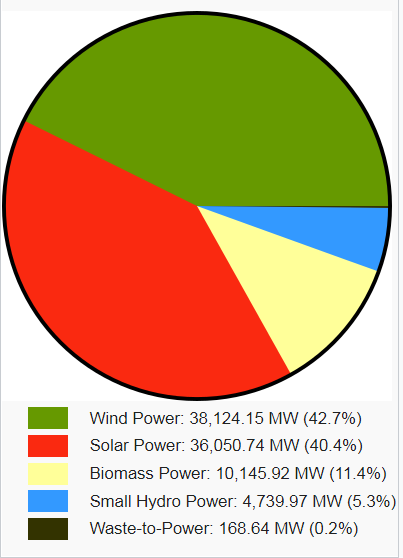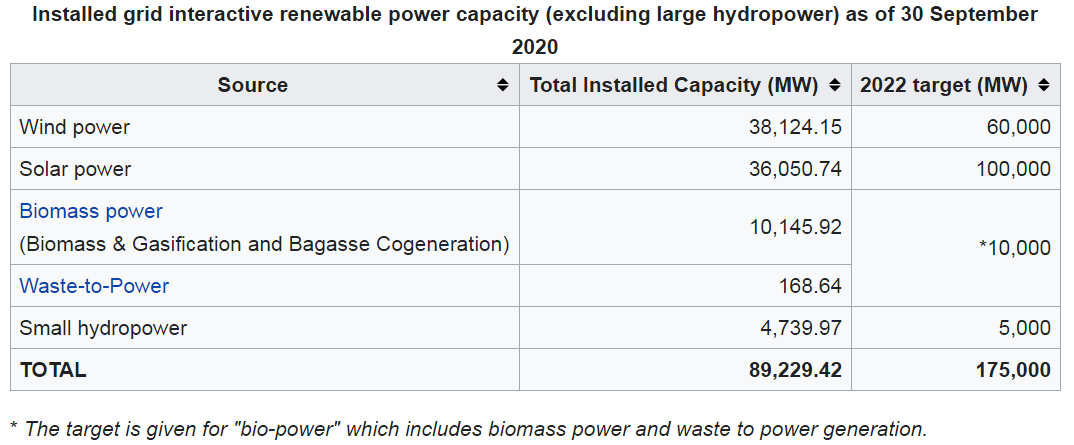





Disclaimer: Copyright infringement not intended.
Context
What Is Renewable Energy?
Types of Renewable Energy Sources
The most common renewable power technologies include:
Wind
This takes advantage of wind motion to generate electricity. Wind motion is brought about by the heat from the sun, and rotation of the earth, mainly via the Coriolis Effect.
Solar
It taps heat from the sun to produce energy for the generation of electricity, heating, lighting homes and commercial buildings.
Hydropower
Utilizes moving water to produce electricity. Moving water creates high energy that can be harnessed and turned into power.
Biomass
Organic matter that constitutes plants is referred to as biomass, which can be utilized to generate electricity, chemicals or fuels to power vehicles.
Ocean
Takes advantage of rising and falling of tides to generate electricity
Geothermal
Leverages heat from underneath the earth to generate electricity.
The Advantages of Renewable Energy Resources
A Fuel Supply That Never Runs Out
Renewable energy is created from sources that naturally replenish themselves – such as sunlight, wind, water, biomass, and even geothermal (underground) heat.
While fossil fuels are becoming harder and more expensive to source – resulting in the destruction of natural habitats and significant financial losses – renewable energy never runs out.
Zero Carbon Emissions
There are no greenhouse gasses or other pollutants created during the process. Coal power plants on the other hand create around 2.2 pounds of CO2 for every kilowatt-hour of electricity.
As we race to decarbonize our world and embrace energy sources that don’t contribute to global warming, renewables are helping to provide us with emission-free energy..
Cleaner environment
Burning fossil fuels causes global warming and causes pollution.
Coal power stations, for example, release high volumes of carbon dioxide (CO2) and nitrous oxide (N2O) directly into the atmosphere – two of the most potent greenhouse gasses. In addition, they also emit mercury, lead, sulfur dioxide, particulates, and dangerous metals – which can cause a host of health problems ranging from breathing difficulties to premature death.
On the other hand, renewable energy creates no pollution, waste, or contamination risks to air and water.
A Cheaper Form of energy
With the rapid growth of renewable energy over the last ten years, solar and wind power are now the cheapest sources of energy in many parts of the world. In the United Arab Emirates a new sun farm recently secured the world’s lowest price of solar energy at just 1.35c per kilowatt-hour.
Whereas green energy was once a “clean-but-expensive” alternative – it’s now helping to reduce energy bills for people in many parts of the world.
Renewable Energy Creates New Jobs
With an increasing focus on global warming and many governments setting ambitious carbon-reduction goals Renewable Energy has quickly become a major source of new job growth.

Challenges of Renewable Energy
Higher Capital Costs
While renewable energy systems need no fuel and can deliver substantial long-term savings, their up-front costs can still be prohibitive.
On a larger scale, wind farms, solar parks, and hydropower stations require significant investment, land, and electrical infrastructure
Electricity Production Can Be Unreliable
Renewable energy systems rely on natural resources such as sunlight, wind, and water, and therefore, their electricity generation can be as unpredictable as the weather. Solar panels lose efficiency on cloudy days, wind turbines aren’t effective in calm weather, and hydropower systems need consistent snow and rainfall to maintain reliable production.
At the same time, when renewable systems produce too much energy, they risk overloading the grid and causing major problems for network operators.
Energy Storage
Due to the intermittent nature of renewables, they need forms of energy storage to capture and release electricity in a consistent and controlled way.
Despite falling costs, storage technology is still relatively expensive.
Renewables still have a Carbon Footprint
While solar panels and wind turbines produce no carbon emissions as they make energy – their manufacturing, transport, and installation still creates a carbon footprint.

Present production

Fig: Installed grid interactive renewable power capacity in India as of 30 September 2020 (excluding large hydro)
MARKET SIZE
As of January 2022, India’s installed renewable energy capacity stood at 152.36 GW, representing 38.56% of the overall installed power capacity. 975.60 MW of renewable energy capacity was added in January 2022. Power generation from renewable energy sources stood at 13.15 billion units (BU) in January 2022, up from 11.51 BU in January 2021.
Achievements of India
Targets
Paris Agreement Targets
Central Electricity Authority's strategy blueprint
UN Climate Summit
Some Government’s Initiatives for generating Renewable Energy
Grid Connected Solar Rooftop Programme
Objective: For achieving cumulative capacity of 40,000 MW from Rooftop Solar (RTS) Projects by the year 2022.
Solar Park Scheme
MNRE has come up with a scheme to set up a number of solar parks across several states, each with a capacity of almost 500 MW. The scheme proposes to offer financial support by the Government of India to establish solar parks to facilitate the creation of infrastructure required for setting up new solar power projects in terms of allocation of land, transmission, access to roads, availability of water, etc.
International Solar Alliance
The International Solar Alliance (ISA) is an alliance of 121 countries initiated by India, most of them being sunshine countries, which lie either completely or partly between the Tropic of Cancer and the Tropic of Capricorn. The primary objective of the alliance is to work for efficient consumption of solar energy to reduce dependence on fossil fuels.
The initiative was launched by Prime Minister Narendra Modi at the India Africa Summit, and a meeting of member countries ahead of the 2015 United Nations Climate Change Conference (COP 21) in Paris in November 2015. The framework agreement of the International Solar Alliance opened for signatures in Marrakech, Morocco in November 2016, and 200 countries have joined. HQ- Gurugram, Haryana
PM KUSUM
Pradhan Mantri Kisan Urja Suraksha evem Utthan Mahabhiyan (PM KUSUM) Scheme for farmers aims for installation of solar pumps and grid connected solar and other renewable power plants in the country.
The scheme aims to add solar and other renewable capacity of 25,750 MW by 2022.
National Green Corridor Project
The green energy corridor is grid connected network for the transmission of renewable energy produced from various renewable energy projects.
National Wind-Solar Hybrid Policy
This policy essentially aims at establishing a structure on the basis of which large-scale wind-solar hybrid power projects can be promoted.
National Offshore Wind Energy Policy
The objective is to develop the offshore wind energy in the Indian Exclusive Economic Zone (EEZ) along the Indian coastline.
Sustainable Rooftop Implementation for Solar Transfiguration of India (SRISTI) scheme
The Central government will offer with financial incentive to the beneficiary for installing Solar power plant rooftop projects within the country.
Biomass power & cogeneration programme
It is being implemented with the main objective of promoting technologies for optimum use of country's biomass resources for grid power generation.
Draft National Wind-Solar Hybrid Policy
The main objective of the Policy is to provide a framework for promotion of large grid connected wind - solar PV hybrid system for optimal and efficient utilization of transmission infrastructure and land, reducing the variability in renewable power generation and achieving better grid stability.
FDI Policy
100% FDI is allowed in the renewable energy sector under the Automatic route and no prior Government approval is needed.
Akshay Urja Portal and India Renewable Idea Exchange (IRIX) Portal
Promotes the exchange of ideas among energy conscious Indians and the Global community.
National Biogas and Manure Management Programme
Central Sector Schemes that provides for setting up of Family Type Biogas Plants mainly for rural and semi-urban/households.
Production Linked Incentive (PLI) Scheme
Incentives for High Efficiency Solar PV Modules for Enhancing India’s Manufacturing Capabilities and Enhancing Exports.
Mission Innovation CleanTech Exchange
In June 2021, India launched the Mission Innovation CleanTech Exchange, a global initiative that will create a whole network of incubators across member countries to accelerate clean energy innovation.
India Renewables Dashboard
In April 2021, the Central Electricity Authority (CEA) and CEEW’s Centre for Energy Finance (CEEW-CEF) jointly launched the India Renewables Dashboard that provides detailed operational information on renewable energy (RE) projects in India.
National Electricity Policy (NEP) 2021
In April 2021, the Ministry of Power (MoP) released the draft National Electricity Policy (NEP) 2021 and has invited suggestions from all stakeholders such as Central Public Sector Undertakings, Solar Energy Corporation of India, power transmission companies, financial institutions like Reserve Bank of India, Indian Renewable Energy Development Agency, HDFC Bank, ICICI Bank, industrial, solar, and wind associations, and state governments.
National Mission on advanced ultra-supercritical technologies
The Government of India has announced plans to implement a US$ 238 million National Mission on advanced ultra-supercritical technologies for cleaner coal utilisation.
Indian Railways Efforts
Indian Railways is taking increased efforts through sustained energy efficient measures and maximum use of clean fuel to cut down emission level by 33% by 2030.
Renewable energy park at the Rann of Kutch in Khavada, Gujarat
In July 2021, the Ministry of New and Renewable Energy (MNRE) gave the go ahead to NTPC Renewable Energy Ltd., a 100% subsidiary of NTPC, to build a 4,750 MW renewable energy park at the Rann of Kutch in Khavada, Gujarat. This will be India's largest solar park to be developed by the country's leading power producer.
|
India’s Focus Areas
Methanol and Biomass
The Twin Challenge
Hydrogen based FCV
Grid Integration
Conclusion







© 2025 iasgyan. All right reserved